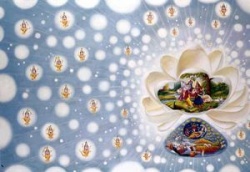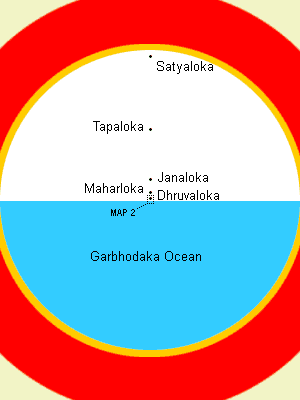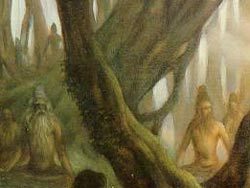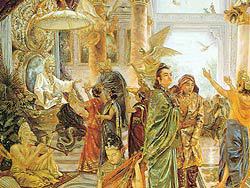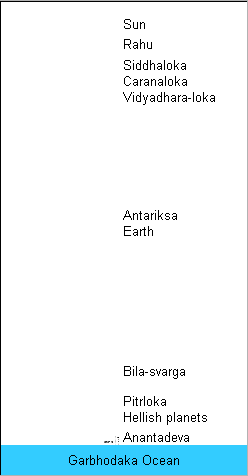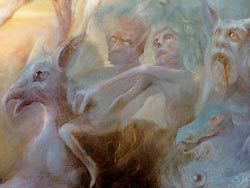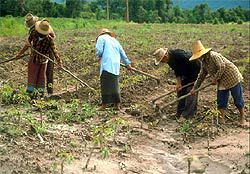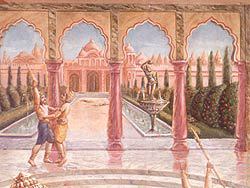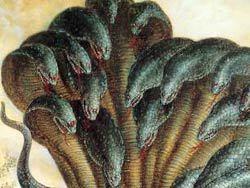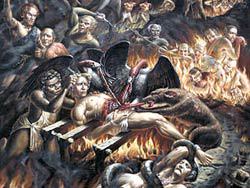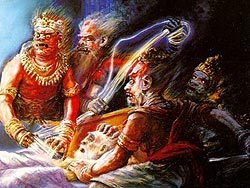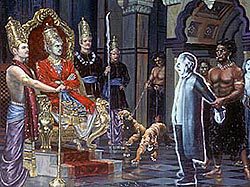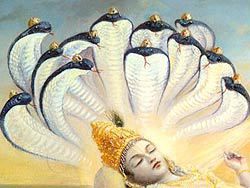Lokas – Locations in Universe as explained by Vedas
Hari Om Tat Sat – Hari is the Absolute Truth, Past Present and Future
Before you read anything below, you have to know that Vedas have been written by globally reknowed scholars over millions of years. Sanskrit is beleived to have come from Demi Gods and Munis or saints.Vedas have been written and acknowledged world wide.
You will find Vedas as Ventas and Sholkas as Slovacs in all over Europe. Sanskrit is the most difficult language on earth and beyond.
To learn it many aspirants came to India and many scholars travelled worldwide for thousands of years. On the fact we have traces sanskrit in european, german, armani and arabic languages.
The Vedas are beleived to have come straight from the mouth of Brahma -the secondary creator of universe, a demi god. Brahma had been appointed by Mahavishnu or GOD to create materialistic world.
These Vedas were then absorbed by Sapta Rishis who spread the knowledge of GOD in this whole world.
The sapta rishis are still a evidence of prior existence according to Astronomy as seven stars in the galaxy. I plead the reader to read this article with full consciousness and leave aside the ego of extremity and ignorance.
Devi-Dhama
This material world is the realm of Durga who is the material energy in her personal form.
“The goddess Durga was decorated with flower garlands, smeared with sandalwood pulp and dressed with excellent garments and ornaments made of valuable jewels.
Holding in her hands a bow, a trident, arrows, a shield, a sword, a conchshell, a disc and a club, and being praised by celestial beings like Apsaras, Kinnaras, Uragas, Siddhas, Caranas and Gandharvas, who worshiped her with all kinds of presentations, she spoke as follows.” (SB 10.4.10-11)
I, jiva, am now just a transcendental sparkle of an atomic size and according to my desire and karma I take birth in various material bodies one after another (the cycle of birth and death,
or samsara) within this world characterized by all-pervading presence of birth, death, old age and disease (janma-mrtyu-jara-vyadhi).
These are symptoms of my conditioned life based on my identification with matter. During my whole stay here I am accompanied by the Lord in His invisible form of Paramatma (Supersoul) in my heart. He lets me act according to my desires and witnesses and approves my actions.
Paramatma – “I am seated in everyone’s heart, and from Me come remembrance, knowledge and forgetfulness. By all the Vedas, I am to be known. Indeed, I am the compiler of Vedanta, and I am the knower of the Vedas.” (BG 15.15)
“Sri Krsna, the Personality of Godhead, who is the Paramatma (Supersoul) in everyone’s heart and the benefactor of the truthful devotee, cleanses desire for material enjoyment from the heart of the devotee who has developed the urge to hear His messages, which are in themselves virtuous when properly heard and chanted.” (SB 1.2.17)
“One who worships the Deity of Godhead in the temples but does not know that the Supreme Lord, as Paramatma, is situated in every living entity’s heart, must be in ignorance and is compared to one who offers oblations into ashes.” (SB 3.29.22)
All the universes are clustered together up and down, and each and every one of them is separately sevenfold-covered. The watery portion is beyond the sevenfold coverings, and each covering is ten times more expansive than the previous covering.
The extent of the cosmic phenomenon is calculated to be diametrically (both ways) four billion miles.
Then the coverings of the universe begin.
The first stratum of the covering (earth) is calculated to extend eighty million miles, and the subsequent coverings of the universe are respectively of fire, effulgence, air and ether, one after another, each extending ten times further than the previous. (SB 2.2.28 p.)1 yojan = 8 miles = 12,8 km Dhruvaloka, the polestar, is 3,800,000 yojanas above the sun.
Above Dhruvaloka by 10,000,000 yojanas is Maharloka, above Maharloka by 20,000,000 yojanas is Janaloka, above Janaloka by 80,000,000 yojanas is Tapoloka, and above Tapoloka by 120,000,000 yojanas is Satyaloka.
Thus the distance from the sun to Satyaloka is 233,800,000 yojanas, or 1,870,400,000 miles.
The Vaikuntha planets begin 26,200,000 yojanas (209,600,000 miles) above Satyaloka. Thus the Visnu Purana describes that the covering of the universe is 260,000,000 yojanas (2,080,000,000 miles) away from the sun. (SB 5.23.9 p.)
Satyaloka
My first body is that of Brahma, the secondary creator of this world. I live on Satyaloka, the topmost dimensional level in this world. If I am a pure devotee of the Lord, at the end of my long life I will return to Hari-dhama together with my associates, great sages. Otherwise I will be born as a great sage on Muniloka.
“Both the Lord and the living entity, being qualitatively spirit soul, have the tendency for peaceful enjoyment, but when the part of the Supreme Personality of Godhead unfortunately wants to enjoy independently, without Krsna, he is put into the material world, where he begins his life as Brahma and is gradually degraded to the status of an ant or a worm in stool.” (SB 9.24.58 p.)
“The yogis who become detached from the material world by practice of breathing exercises and control of the mind reach the planet of Brahma, which is far, far away.
After giving up their bodies, they enter into the body of Lord Brahma, and therefore when Brahma is liberated and goes to the Supreme Personality of Godhead, who is the Supreme Brahman, such yogis can also enter into the kingdom of God.” (SB 3.32.10)
Muniloka
Muniloka is the general name of the abodes of great sages: Tapoloka, Janaloka, Maharloka.
These sages constantly meditate on the Lord. Here I’m one of the sages and by my meditation I can go either higher, up to Satyaloka, to become Brahma’s associate, or down, to the level of devas (demigods).
“By mystic yoga, great austerities and the renounced order of life, the pure destinations of Maharloka, Janoloka, Tapoloka and Satyaloka are attained. But by devotional yoga, one achieves My transcendental abode.” (SB 11.24.14)
The moon is situated 100,000 yojanas above the rays of the sunshine.
Day and night on the heavenly planets and Pitrloka are calculated according to its waning and waxing.
Above the moon by a distance of 200,000 yojanas are some stars, and above these stars is Sukra-graha (Venus), whose influence is always auspicious for the inhabitants of the entire universe.
Above Sukra-graha by 200,000 yojanas is Budha-graha (Mercury), whose influence is sometimes auspicious and sometimes inauspicious.
Next, above Budha-graha by 200,000 yojanas, is Angaraka (Mars), which almost always has an unfavorable influence.
Above Angaraka by another 200,000 yojanas is the planet called Brhaspati-graha (Jupiter), which is always very favorable for qualified brahmanas.
Above Brhaspati-graha is the planet Sanaiscara (Saturn), which is very inauspicious, and above Saturn is a group of seven stars occupied by great saintly persons who are always thinking of the welfare of the entire universe.
These seven stars circumambulate Dhruvaloka, which is the residence of Lord Visnu within this universe. (SB 5.22) Moon distance
Svargaloka
Svargaloka is the abode of demigods. I’m now Indra (the chief demigod) or one of the other demigods in a cosmic hierarchy (agnir vai devAnAm avamo viSNuH paramas, tadantareNa sarvA anyA devatA – “Agni is the lowest and Vishnu is the highest among devas.
All other gods occupy positions that are in between.” Aitareya Brahmana 1.1.1) and my duty is to manage the affairs of the universe, protecting its inhabitants against the asuras (demons) as an empowered servant of the Lord.
If I become advanced in my devotional service, I will be born as a sage in Muniloka. If I become attached to material enjoyment, I will degrade into a lower position becoming a semi-demigod or a human being.
“Men of small knowledge are very much attached to the flowery words of the Vedas, which recommend various fruitive activities for elevation to heavenly planets, resultant good birth, power, and so forth. Being desirous of sense gratification and opulent life, they say that there is nothing more than this.” (BG 2.42-43)
Neither the demigods controlling fire, the sun, the moon and the stars nor those in charge of earth, water, ether, air, speech and mind actually remove the sins of their worshipers, who continue to see in terms of dualities. But wise sages destroy one’s sins when respectfully served for even a few moments. (SB 10.84.12)
Indra: “We are now living in the heavenly planets, undoubtedly as a result of our having performed ritualistic ceremonies, pious activities and yajnas and having studied the Vedas.
However, our lives here will one day be finished. We pray that at that time, if any merit remains from our pious activities, we may again take birth in Bharata-varsa as human beings able to remember the lotus feet of the Lord.
The Lord is so kind that He personally comes to the land of Bharata-varsa and expands the good fortune of its people.” (SB 5.19.28)
Bhuvarloka
Bhuvarloka – the level of semi-demigods (Carana, Vidyadhara, Kinnara, Kimpurusa etc.).
As one of the lesser demigods I am assisting the demigods in various ways and sometimes interacting with the humans.
By advancement in my service I can become a demigod or to subdue to the enjoying nature and be born as a human on the earthly level, Bhurloka.
Semi-demigods - “Below Rahu by 10,000 yojanas [80,000 miles] are the planets known as Siddhaloka, Caranaloka and Vidyadhara-loka.” (SB 5.24.4)
“While He was passing in the northern direction, all the celestial denizens known as Caranas and Gandharvas, as well as the munis and the damsels of the heavenly planets, prayed and offered Him all respects. The ocean offered Him oblations and a place of residence.” (SB 3.33.34)
Rahu is situated 10,000 yojanas below the sun. Below Rahu by another 10,000 yojanas are the planets of the Siddhas, Caranas and Vidyadharas, and below these are planets such as Yaksaloka and Raksaloka.
Below these planets is the earth, and 70,000 yojanas below the earth are the lower planetary systems Bila-svarga: Atala, Vitala, Sutala, Talatala, Mahatala, Rasatala and Patala.
Demons and Raksasas live in these lower planetary systems with their wives and children, always engaged in sense gratification and not fearing their next births.
The sunshine does not reach these planets, but they are illuminated by jewels fixed upon the hoods of snakes. Because of these shining gems there is practically no darkness.
Those living in these planets do not become old or diseased, and they are not afraid of death from any cause but the time factor, the Supreme Personality of Godhead.
In the planet Atala, the yawning of a demon has produced three kinds of women, called svairini (independent), kamini (lusty) and pumscali (very easily subdued by men).
Below Atala is the planet Vitala, wherein Lord Siva and his wife Gauri reside. Because of their presence, a kind of gold is produced called hataka.
Below Vitala is the planet Sutala, the abode of Bali Maharaja, the most fortunate king. Bali Maharaja was favored by the Supreme personality of Godhead, Vamanadeva, because of his intense devotional service.
Below Sutala is the planet Talatala, the abode of the demon Maya.
This demon is always materially happy because he is favored by Lord Siva, but he cannot achieve spiritual happiness at any time.
Below Talatala is the planet Mahatala, where there are many snakes with hundreds and thousands of hoods.
Below Mahatala is Rasatala, and below that is Patala (Nagaloka), where the serpent Vasuki lives with his associates. (SB 5.24)The hellish planets are situated in the intermediate space between the three worlds and the Garbhodaka Ocean.
They lie on the southern side of the universe, beneath Bhu-mandala, and slightly above the water of the Garbhodaka Ocean.
Pitrloka is also located in this region between the Garbhodaka Ocean and the lower planetary systems. All the residents of Pitrloka, headed by Agnisvatta, meditate in great samadhi on the Supreme Personality of Godhead and always wish their families well. (SB 5.26.5)
Approximately 240,000 miles beneath the planet Patala lives Lord Ananta. This great universe, situated on one of Lord Anantadeva’s thousands of hoods, appears just like a white mustard seed. It is infinitesimal compared to the hood of Lord Ananta. (SB 5.25.1-2)
The distance from the sun to the earth is lower planetary systems called Atala, Vitala, Sutala, Talatala, Mahatala, Rasatala and Patala.
Below these lower planets by 30,000 yojanas, Sesa Naga is lying on the Garbhodaka Ocean.
That ocean is 249,800,000 yojanas deep. Thus the total diameter of the universe is approximately 500,000,000 yojanas, or 4,000,000,000 miles. (SB 5.23.9 p.)
Antariksa
Between Bhuvarloka and Bhurloka is antariksa, an interplanetary space where the Sun is situated. Here live beings like Raksasas, Yaksas, Pisacas and ghosts.
They often descend on earth and are generally inimical to humans. Usuallly they will be born later as humans.
Ghosts – “Living entities who are associates of Rudra develop in the third mode of material nature, or ignorance. They are situated in the sky between the earthly planets and the heavenly planets.” (SB 3.6.29)
“Beneath Vidyadhara-loka, Caranaloka and Siddhaloka, in the sky called antariksa, are the places of enjoyment for the Yaksas, Raksasas, Pisacas, ghosts and so on.
Antariksa extends as far as the wind blows and the clouds float in the sky. Above this there is no more air.” (SB 5.24.5)
Bhurloka
Bhurloka, or Bhu-mandala is the earthly level consisting of seven spheres (dvipas) – Jambudvipa, Plaksadvipa, Salmalidvipa, Kusadvipa, Krauncadvipa, Sakadvipa, Puskaradvipa – which are inhabited by various human beings.
“The planetary system known as Bhu-mandala resembles a lotus flower, and its seven islands resemble the whorl of that flower. The length and breadth of the island known as Jambudvipa, which is situated in the middle of the whorl, are one million yojanas [eight million miles].
Jambudvipa is round like the leaf of a lotus flower.” (SB 5.16.5)
he planet Earth where I live now as a human being is situated within Jambudvipa.
It is known as karma-bhumi (Visnu Purana 2.3.2), the place where new karma is created, a kind of cosmic crossroad. Here I will decide about my future situation, higher or lower, by acting in a particular way (not that “all paths are the same” – yatha mata tatha pata).
“King Rahugana said: This birth as a human being is the best of all. Even birth among the demigods in the heavenly planets is not as glorious as birth as a human being on this earth.
What is the use of the exalted position of a demigod? In the heavenly planets, due to profuse material comforts, there is no possibility of associating with devotees.” (SB 5.13.21)
Bila-Svarga
Bila-svarga is the name of subterranean ‘heavens’ inhabited by the asuras and the Nagas.
Bhagavata Purana lists seven of them, one below another: Atala, Vitala, Sutala, Talatala, Mahatala, Rasatala and Patala.
Bila-svarga – “In these seven planetary systems, which are also known as the subterranean heavens ((bila-svarga)]), there are very beautiful houses, gardens and places of sense enjoyment, which are even more opulent than those in the higher planets because the demons have a very high standard of sensual pleasure, wealth and influence.
Most of the residents of these planets, who are known as Daityas, Danavas and Nagas, live as householders.
Their wives, children, friends and society are all fully engaged in illusory, material happiness.
The sense enjoyment of the demigods is sometimes disturbed, but the residents of these planets enjoy life without disturbances. Thus they are understood to be very attached to illusory happiness.” (SB 5.24.8)
Asuras – “Now let me describe the sons of Diti, who were begotten by Kasyapa but who became demons.
In this demoniac family the great devotee Prahlada Maharaja appeared, and Bali Maharaja also appeared in that family.
The demons are technically known as Daityas because they proceeded from the womb of Diti.” (SB 6.18.10)
“Beneath Mahatala is the planetary system known as Rasatala, which is the abode of the demoniac sons of Diti and Danu.
They are called Panis, Nivata-kavacas, Kaleyas and Hiranya-puravasis [those living in Hiranya-pura.
They are all enemies of the demigods, and they reside in holes like snakes.
From birth they are extremely powerful and cruel, and although they are proud of their strength, they are always defeated by the Sudarsana cakra of the Supreme Personality of Godhead, who rules all the planetary systems.
When a female messenger from Indra named Sarama chants a particular curse, the serpentine demons of Mahatala become very afraid of Indra.” (SB 5.24.30)
Nagas – “Beneath Rasatala is another planetary system, known as Patala or Nagaloka, where there are many demoniac serpents, the masters of Nagaloka, such as Sankha, Kulika, Mahasankha, Sveta, Dhananjaya, Dhrtarastra, Sankhacuda, Kambala, Asvatara and Devadatta.
The chief among them is Vasuki.
They are all extremely angry, and they have many, many hoods – some snakes five hoods, some seven, some ten, others a hundred and others a thousand.
These hoods are bedecked with valuable gems, and the light emanating from the gems illuminates the entire planetary system of bila-svarga.” (SB 5.24.31)
I have become one of the asuras or Nagas, half human and half serpent beings, who are enjoying high standard of material life on sub-earthly levels. I am endowed with supernatural powers, totally irreligious and usually inimical to humans.
This seemingly ideal life is interrupted from time to time – I am killed by Lord’s Sudarsana chakra and born as a human.
Hells – Narakas
Hells (Naraka) – the lowest levels in the universe, places to suffer for committing specific vikarmas for a determined time. Yamadutas are bringing me to Yamaraja, the judge of the dead.
He will determine the type and length of my punishment according to dharma sastras. After my punishment is over I will be born as an animal.
“While living one may be proud of one’s body, thinking oneself a very big man, minister, president or even demigod, but whatever one may be, after death this body will turn either into worms, into stool or into ashes.
If one kills poor animals to satisfy the temporary whims of this body, one does not know that he will suffer in his next birth, for such a sinful miscreant must go to hell and suffer the results of his actions.” (SB 10.10.10)
“As directed by Citragupta, he suffers in hell.
Having suffered tortures there, he is born in low species. …”
“When the expiatory and deterrent tortures in hell cease, the living beings are born again in human (or animal – 28) form with the characteristic traits of their sins. O foremost among birds, I shall tell you what these signs are.” (Garuda Purana 2.10.88-89, 2.46.9-10,28)
Yamadutas – “Those who have passed several years in the dreadful hell and have no descendants (to offer gifts) in their favor become messengers of Yama.” (Garuda Purana 2.18.34)
As a criminal is arrested for punishment by the constables of the state, a person engaged in criminal sense gratification is similarly arrested by the Yamadutas, who bind him by the neck with strong rope and cover his subtle body so that he may undergo severe punishment. (SB 3.30.20)
Yamaraja – The Judger of Sins – Dharmaraja or king of righteous thinking.
Yamaraja – “The King of the pitas [[[Wikipedia:ancestors|ancestors]]] is Yamaraja, the very powerful son of the sun-god.
He resides in Pitrloka with his personal assistants and, while abiding by the rules and regulations set down by the Supreme Lord, has his agents, the Yamadutas, bring all the sinful men to him immediately upon their death.
After bringing them within his jurisdiction, he properly judges them according to their specific sinful activities and sends them to one of the many hellish planets for suitable punishments.” (SB 5.26.6)
Lord Ananta
Approximately 240,000 miles beneath the planet Patala lives another incarnation of the Supreme Personality of Godhead.
He is the expansion of Lord Visnu known as Lord Ananta or Lord Sankarsana.
He is always in the transcendental position, but because He is worshiped by Lord Siva, the deity of tamo-guna or darkness,
He is sometimes called tamasi. Lord Ananta is the predominating Deity of the material mode of ignorance as well as the false ego of all conditioned souls.
When a conditioned living being thinks, “I am the enjoyer, and this world is meant to be enjoyed by me,” this conception of life is dictated to him by Sankarsana.
Thus the mundane conditioned soul thinks himself the Supreme Lord.
This great universe, situated on one of Lord Anantadeva’s thousands of hoods, appears just like a white mustard seed.
It is infinitesimal compared to the hood of Lord Ananta. At the time of devastation, when Lord Anantadeva desires to destroy the entire creation,
He becomes slightly angry.
Then from between His two eyebrows appears three-eyed Rudra, carrying a trident.

